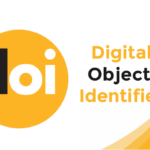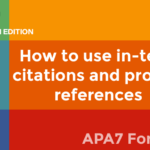In much the same way individuals have ID numbers that correspond to them precisely, online articles and journals also have specific numbers and symbols that identify them in web databases. Standing for Digital Object Identifier, a DOI is a unique sequence corresponding to a single digital media piece. Plugging this DOI into any online search engine (Google, Yahoo!, Safari, etc.) will lead to its specific article and localize it in any database.
A DOI has two components, the prefix, and the suffix, separated by a forward slash (/). The DOI is usually clearly visible upon opening an article. The following are all examples of online peer-reviewed journal articles, highlighting where the DOI can be found in each one:
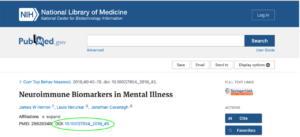

History
The concept of a DOI was first brought up by the AAP (American Association of Publishers), who took the initiative to develop an identification system for digital networks. ISBNs (International Standard Book Numbers)—which identify printed books—had been around since the 1970s, and a group of people in the publishing industry who recognized the fast-approaching digital boom soon realized the need for a similar system in the digital sphere. In March of 1996, this association requested help from partners in the technology industry to design and administer what would come to be known as the DOI system. The Digital Object Identifier program was officially launched at the Frankfurt Book Fair in October 1997. The International DOI Foundation (IDF) was created that same year to manage the DOI system.
 Author Salman Rushdie at the Frankfurt Book Fair in 1998, a year after the DOI was opened to the public.
Author Salman Rushdie at the Frankfurt Book Fair in 1998, a year after the DOI was opened to the public.
Uses & Mechanism
The DOI is an absolute necessity for organizing and citing data in our digital age. Electronic content is as vast as it is available, and it can be easy to lose track of publications or confuse them with pre-existing ones.
|
Table 1. Examples of resources that use the DOI system |
|
o Journal Articles o Research Reports o Official Publications o Governmental Reports o Conference Proceedings o E-books o Data Sets
|
To prevent these issues, a unique and permanent alphanumeric string is assigned to every piece of published digital media with the DOI system enabled, identifying said document across the web. DOIs are now widely used to manage academic, professional, and government information (see table 1.) A document’s DOI not only serves as identification but as a claim on intellectual property, as it leads precisely to the original document written by the original authors (and once the DOI is established, it cannot be changed, hence its permanent nature).
An assigned DOI remains fixed over its document’s lifetime, even if its location or other data may change. Because of this, DOIs tend to be more directly reliable than URLs (have you ever clicked on a link only to find that it no longer exists?). Additionally, they also make it much easier to retrieve work. The DOI system is engineered to perform multiple functions, chief among them being the regulation and management of digital media. It facilitates content management and enables better development of databases. Through its cataloging system, DOIs allow users to know what content they have available, where precisely this content exists, and find and use it whenever necessary.
Why use it?
For us students, it is essential to know what the DOI is and how to use it, as it is perhaps the most important part of a citation and can help you (or your reader) find an article anywhere on the web. For APA7 format, it is required to add the DOI precisely as shown in the source at the end of any reference. APA style guidelines state that you must “include a DOI for all works that have a DOI, regardless of whether you used the online version or the print version” (APA Style – DOIs and URLs 2019).
Let’s look at the following example.
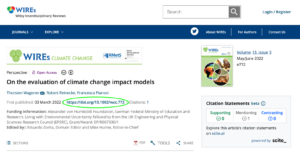 By APA rules, the reference for the journal article above would be as follows (with the DOI in red):
By APA rules, the reference for the journal article above would be as follows (with the DOI in red):
Wagener, T., Reinecke, R., & Pianosi, F. (2022). On the evaluation of climate change impact models.
WIREs Climate Change, 13(3). https://doi.org/10.1002/wcc.772
How to generate a DOI
DOIs can be generated for most work, so long as it is unpublished beforehand. If your work—be it an article, book, paper, or other—has been previously published elsewhere, a DOI cannot be generated for it. You must also ensure that the research you are working with supports adding a DOI.
To create a DOI for your work, you should use a specific DOI Registration Agency (RA) service. RAs collect the necessary metadata* and assign the DOI name, offering you additional services like reference linking and metadata lookup. A list of DOI Registration Agencies taken directly from the DOI.ORG® website can be found at the right. Choose the RA that best suits your needs and create an account with your chosen service. Each site has specific instructions for linking your material to the DOI database.
If a work already has a DOI but needs to be updated, you can ask your publisher to issue one directly.
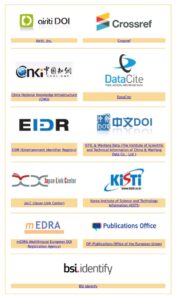
*What’s metadata?
Metadata are sets of data that give information about other data. This might sound complex, but it basically means that metadata is responsible for providing information about different aspects of any given data, summarizing basic information about it so that tracking and working with the data becomes easier.
- Meta comes from the Greek word μετά (meta), meaning “after” or “beyond”.
Sources
APA Style – DOIs and URLs. American Psychological Association. (2019, September). Retrieved October 3, 2022, from https://apastyle.apa.org/style-grammar-guidelines/references/dois-urls
Digital Object Identifier System Handbook. (2019, December 19). Retrieved September 30, 2022, from https://www.doi.org/hb.html
DOI®. (2022, January 27). DOI Registration Agencies. DOI.org. Retrieved October 17, 2022, from https://www.doi.org/registration_agencies.html










